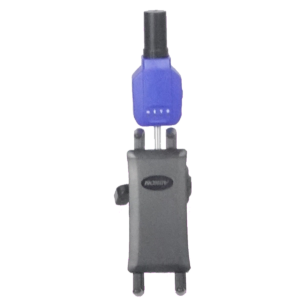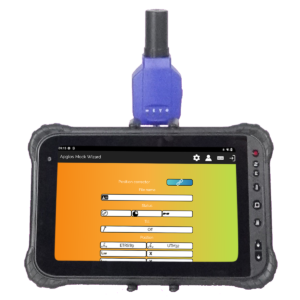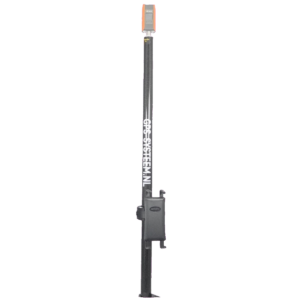How accurate is GPS is a very good question when you want to survey with GPS. When you survey, you want the results to be accurate and precise.
A frequently asked question is therefore: how accurate is GPS? The only correct answer to the question of how accurate GPS is is that it depends on many factors and that the accuracy is between a centimeter and a few decimeters. The factors that influence include the number of satellites from which the GPS receiver receives satellite signals and the position of the satellites in relation to the GPS receiver. If the accuracy of the GPS receiver is at centimeter level, this is an RTK fix. The other accuracy levels also have a name. However, an RTK fix is necessary for surveying with GPS, otherwise the survey results will not be accurate enough. This RTK fix for GPS surveying can be obtained, among other things, by using NTRIP or a local base station.
To clarify everything about this topic, we will answer the following questions in this article:
- What is the accuracy of GPS?
- What Factors Affect the Accuracy of GPS?
- What are the different accuracy levels of GPS?
- What is the required accuracy for surveying with GPS?
- How is the difference in accuracy between a GPS navigation system and GPS measuring equipment achieved?
How accurate is GPS?: the solution
You may not be able to read this entire article. Therefore, there is one more opportunity to learn more about How Accurate is GPS?.
You can try a GPS measuring system via this website. You can then see for yourself how accurate GPS is. Please look directly at this page .
You can request a demonstration of one of our GPS measuring systems on the same page. During this demonstration you can ask specific questions about how accurate GPS is and of course also about other topics related to GPS surveying.
If you do not have time for a demonstration or would like to quickly try out the software of our GPS measuring systems, this is possible. Apglos Survey Wizard is the easiest software to perform GPS measurements. You can download it for free from the Google Play Store .
The Apglos Survey Wizard surveying app has full functionality with the GPS of your Android device. So you can fully test this app and it is free.
Of course, the accuracy of our GPS receivers is better than that of standard Android devices. But you can read all about that on this page. Therefore, if you would like to test with an accurate GPS system, please visit this page .
What is the accuracy of GPS?
How accurate is GPS? is a frequently asked question. Asking the question is easier than answering it. GPS is not always accurate.
You have probably navigated with Google Maps. And on Google Maps you can see where you are with a blue dot. However, in Google’s Android app Maps Go you will also see a large blue circular area around this point.
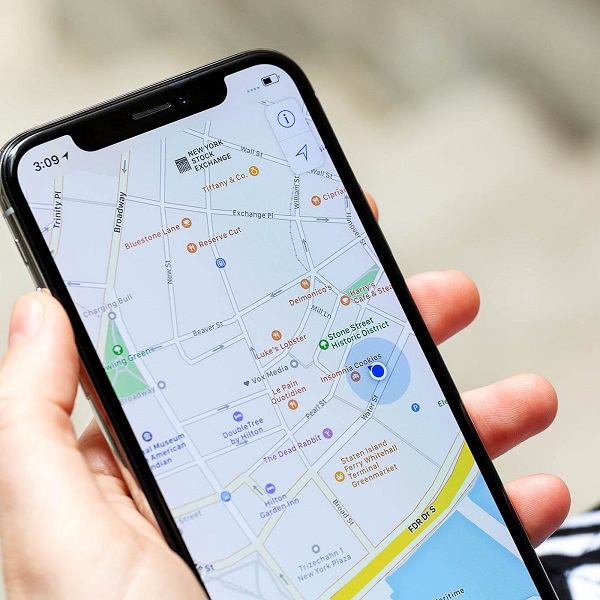
This blue round area shows the inaccuracy. The larger the circular area, the greater the chance that the blue dot is not exactly where you are.
If you use another app for navigation, you will probably see your position change occasionally. This also indicates the inaccuracy of GPS.
As you can see in your navigation app, the accuracy of GPS is not absolute. This can differ on a telephone from a few meters to a few decameters. However, with GPS measuring equipment an accuracy of almost one centimeter can be achieved.
What Factors Affect the Accuracy of GPS?
And there is already a factor regarding the accuracy of GPS. GPS measuring equipment has a larger antenna than a GPS in a telephone. This allows GPS measuring equipment to receive satellite signals more and more easily.
And the more satellite signals are received, the more accurately the position can be determined with GPS. That is also one of the reasons why the GPS measuring equipment is often placed on a measuring stick of 2 meters or higher.
By placing the GPS receiver on a high stick, the GPS receiver is less affected by obstacles. And when there are fewer obstacles, the GPS receiver can receive more satellite signals and therefore determine the position more accurately.
Obstacles for GPS measuring equipment and GPS in general are, for example, tall trees and buildings. The satellite signals cannot pass through these obstacles. This means that the GPS receiver cannot receive the blocked satellite signals. This makes it more difficult for the GPS receiver to determine an exact position.
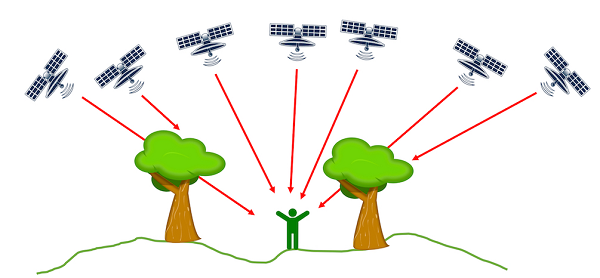
But in addition to the amount of satellite signals that the GPS receiver receives, the position of the satellites relative to the GPS receiver is also important. When all satellites are on one side of the GPS receiver, it is more difficult for a GPS receiver to determine an accurate position.
A good distribution of the satellites is therefore important for the accuracy of GPS. Fortunately, more and more satellites are entering orbit around the earth, with which GPS receivers can determine a position.
At first there were only GPS satellites. But now there are also satellites from GLONASS, GALILEO and BEIDOU.
Another factor that affects the accuracy of GPS is the atmosphere. The satellite signals travel from the satellites through the atmosphere to the GPS receiver. The atmosphere is not always the same. This causes some disruption to the satellite signals. Due to this disruption, the position cannot be determined exactly with GPS without aids.
What are the different accuracy levels of GPS?
However, for navigation, the accuracy of position determination with GPS without aids is often more than sufficient.
This is also logical, because this accuracy is often around decameters. And since a road is usually about 5 to 6 meters and there is no other road directly next to it, the navigation can easily determine which road you are driving on.
Surveying requires greater accuracy. This already shows that there are different accuracy levels for GPS.
The great thing about GPS is that it indicates how accurate the position is. The GPS receiver does this, but also your phone in the language of GPS or NMEA. NMEA how GPS communicates position with other devices.
An important rule of NMEA is the GGA rule. This line indicates the position, but also the accuracy. A GGA rule looks like this:
$GPGGA,172814.0,3723.46587704,N,12202.26957864,W,2,6,1.2,18.893,M,-25.669,M,2.0,0031*4F
The different data in a GGA line are separated by the , sign. If you do that for the above line you will get the following:
| Number | Example | Meaning |
| 1 | $GPGGA | Type NMEA line |
| 2 | 172814.0 | The standard time based on the atomic clock |
| 3 | 3723.46587704 | Latitude |
| 4 | N | The direction of latitude |
| 5 | 12202.26957864 | Longitude |
| 6 | W | The direction of the longitude |
| 7 | 2 | The quality indicator of the GPS position |
| 8 | 6 | The number of satellites that the GPS receiver uses |
| 9 | 1.2 | HDOP |
| 10 | 18,893 | The orthometric height |
| 11 | M | The unit of orthometric height |
| 12 | -25,669 | The geoidal separation |
| 13 | M | The unit of the geoidal separation |
| 14 | 2.0 | Age |
| 15 | 0031 | The ID of the reference station |
| 16 | 4F | End of line |
What is important for the accuracy of GPS is number 7 or the quality indicator of the GPS position.
There are different quality levels with the associated accuracies.
| Quality level | Accuracy |
| RTK | 1-2 cm |
| Float RTK | 10-20 cm |
| DGPS | 1-5 m |
| SPS | >10 m |
The quality levels are broadly indicated in the table above. It is an indication of what accuracy you can expect at what quality level.
What is the required accuracy for surveying with GPS?
It is clear from the table that the highest quality level with the best accuracy is RTK. This is also the only level of quality and accuracy at which you should be able to survey with GPS.
You do not want to measure with a higher degree of inaccuracy. Inaccurate measuring means poorer measurement results. And worse measurement results mean a worse end result and that ultimately leads to higher costs.
That is why all our GPS measuring systems use the Apglos Survey Wizard software. In addition to being the easiest GPS measuring software, it has a number of advantages.
At the top left in the orange bar directly above the map you will see the GPS quality indicator.
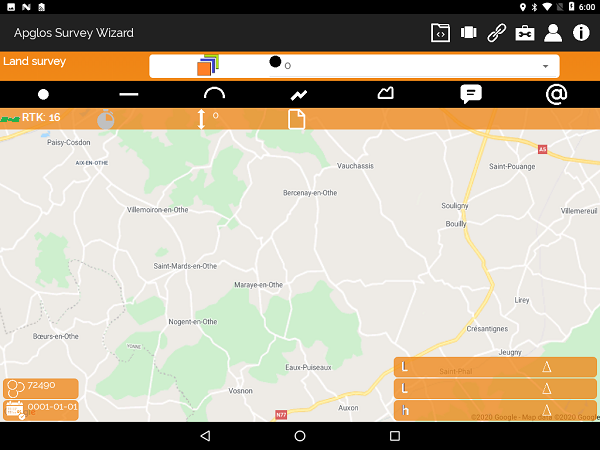
This must therefore be RTK to measure accurate values. The great thing about Apglos Survey Wizard is that you cannot measure with a poorer quality level. You cannot measure for the indications Float RTK, DGPS and SPS.
This ensures that you only collect accurate measurement results. This gives you a good and reliable basis for the continuation of your project. And that leads to a better end result, which also saves costs.
How is the difference in accuracy between a GPS navigation system and GPS measuring equipment achieved?
However, I previously described that tools are needed to obtain centimeter accuracy (RTK) with GPS measuring equipment.
The atmosphere is a disturbing factor for the satellite signals. Therefore, when using GPS measuring equipment, the satellite signals must be compared with the satellite signals at a fixed point.
There is also a GPS receiver at the fixed point. The satellite signals that the GPS receiver receives at the fixed point are compared with the satellite signals from the GPS receiver in the field. The position of the GPS receiver in the field is then corrected based on this equation.
This calculates an accurate position using GPS measuring equipment. The shorter the distance between the GPS receiver at the fixed point and the GPS receiver in the field, the better the correction and the more accurate the position determination.
This comparison can actually be done in two ways. The first is using NTRIP. The GPS receiver connects via the internet to a number of GPS receivers at various fixed points. The distance to the various fixed points is determined based on the position of the GPS receiver in the field. You will then receive the corrections from the GPS receiver at the fixed point closest to the GPS receiver in the field.
Another way is to set up a base yourself. A base is a GPS receiver that remains in one place for a longer period of time, allowing it to determine the position exactly and accurately. Also with this basis, the satellite signals from the GPS receiver can be corrected in the field, allowing an accurate position to be determined.
In the video above you can see how to set up the rover base solution to measure accurately with GPS.
Final conclusion about How accurate is GPS?
This was a whole article on How Accurate GPS Is. There is a lot to report on this topic of GPS surveying. We hope that you have learned at least a few things from it and that you can benefit from them.
However, everything written in this article is theory. If you want to put this theory into practice, you can.
You can try or buy a GPS measuring system via this website . When you do that, you can immediately put into practice what you learned from reading this article about how accurate GPS is. And you can see whether working with our GPS measuring equipment is something for you.
Of course, when you try or buy one of our GPS measuring systems, you will receive a short and clear explanation, so that you can get started right away.
If you would like a demonstration first, you can also request one via the pages mentioned above. During a demonstration or a brief explanation, you can also ask specific questions about how accurate GPS is.

